Mustang_Charly
Member
...or can I just use rubber (stock 289, stock mechanical pump, edelbrock carb and manifold). The fuel inlet to the carb is made for a hose, so I was just wondering. My steel line has a couple of holes in it, and it seems it would be easier just to cut it off near the pump and attach a rubber hose all the way up to the carb.




